Vietnam’s Children Of Agent Orange: Photos Of A Lives Undone By A Poisonous War
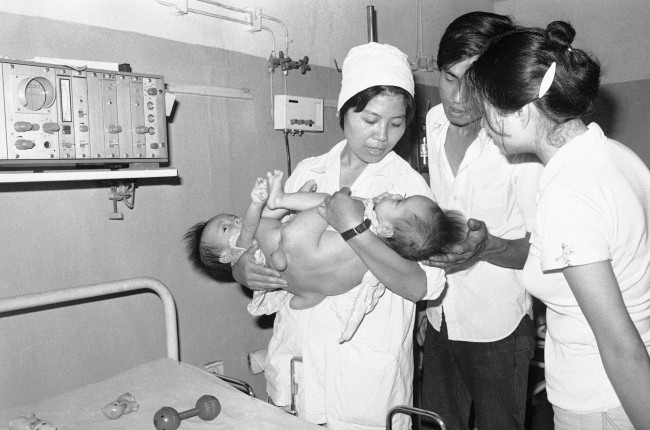
Year-old conjoined twins being cared for at HanoiÂs Viet-Duc hospital, a center for treating deformed children and others who may have been affected by exposure to the defoliant Agent Orange, employed by U.S. forces during the war, are shown May 30, 1982.
IN 2007, David Guttenfelder recorded the legacy of the US Army’s use of the defoliant Agent Orange in Vietnam for the Associated Press.
The most shocking photograph is of five-year-old girl Tran Huynh Thuong Sinh, who was born without eyes in the Binh Dinh province of Vietnam. We see her being fed breakfast by a nurse at the “Peace Village” centre at Tu Du hospital in Ho Chi Minh City.
The Peace Village was established in 1991 and provides a home and education for 92 children and young people who are suffering from the effects of Agent Orange (their age are between 2 and 22). The aim of the village is to care for these children & help them integrate into society.
Officials at the hospital suspect that the dioxin in Agent Orange blocks the receptors in a developing foetus, preventing the hormones that would normally instruct the cells to form eyes from doing so.
We also see the former US Danang airbase in Danang. Test on the ground and water recorded extraordinarily high levels of health-threatening contamination.
Danang in central Vietnam is thought to have the highest level of congenital deformity in the world.
The Vietnamese suffered. So too did the US soldiers exposed to the poison. Their fight for recompense goes on.
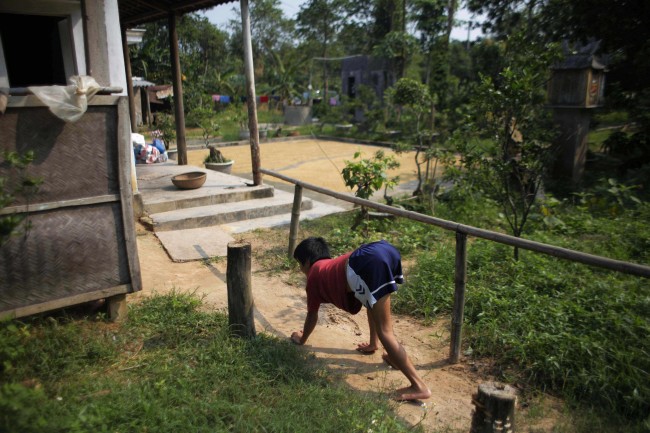
In this photo taken on Oct. 5, 2009, Tran van Hoang walks on all fours as he returns to his family home in the village of Cam Tuyen, Vietnam. The young man was born with profound physical and mental disabilities that his family, and local officials, say were caused by his parents’ exposure to the chemical dioxin in the defoliant Agent Orange.
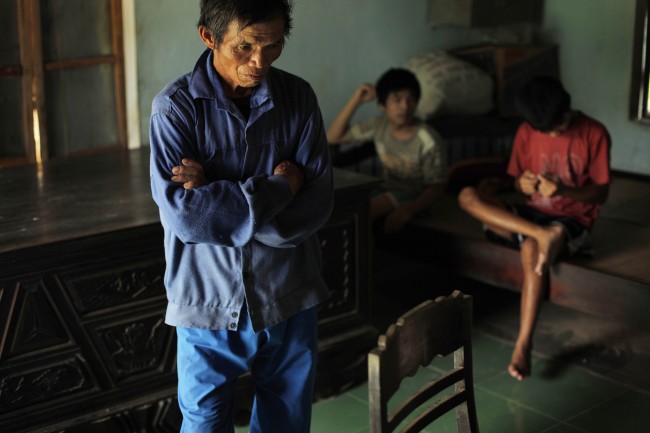
In this photo taken on Oct. 5, 2009, Tran Van Tram, 60, stands inside his home in the village of Cam Tuyen, Vietnam. Tran Van Tram and his wife have raised four children with profound physical and mental disabilities that the family, and local officials say, were caused by his parents’ exposure to the chemical dioxin in the defoliant Agent Orange.
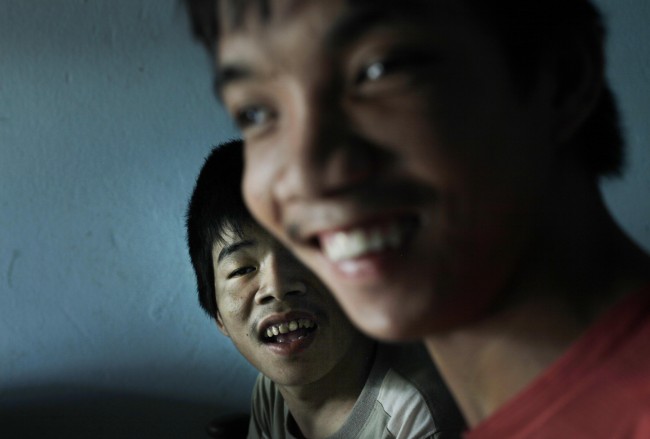
In this photo taken on Oct. 5, 2009, Tran Van Lam, left, and Tran van Hoang sit inside their family home in the village of Cam Tuyen, Vietnam. The two men were born with profound physical and mental disabilities that the family, and local officials, say were caused by their parents’ exposure to the chemical dioxin in the defoliant Agent Orange.
Dr. James Clary, Air Force scientist in Vietnam, says the Air Force knew Agent Orange was far more hazardous to the health of humans than anyone would admit at the time:
“When we [military scientists] initiated the herbicide program in the 1960s, we were aware of the potential for damage due to dioxin contamination in the herbicide. We were even aware that the military formulation had a higher dioxin concentration than the civilian version, due to the lower cost and speed of manufacture. However, because the material was to be used on the enemy, none of us were overly concerned.” (1988 letter from Clary to a member of Congress)
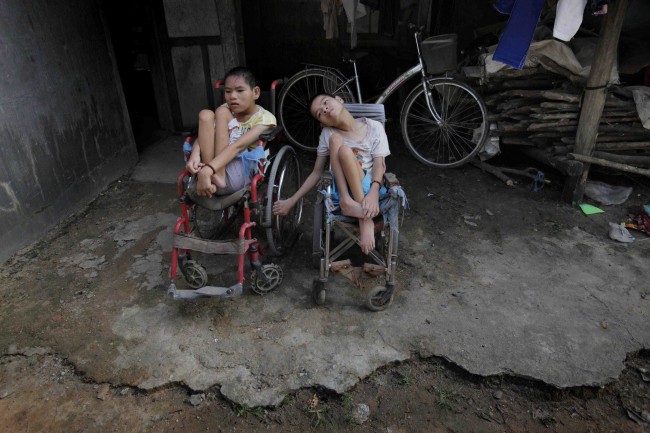
In this photo taken on Oct. 5, 2009, Nguyen Thi Tai, left, and Nguyen Thi Thuyet sit together in their wheelchairs outside their family home in the village of Cam Tuyen, Vietnam. The two young women were born with profound physical and mental disabilities that the family, and local officials say, were caused by their parents’ exposure to the chemical dioxin in the defoliant Agent Orange.
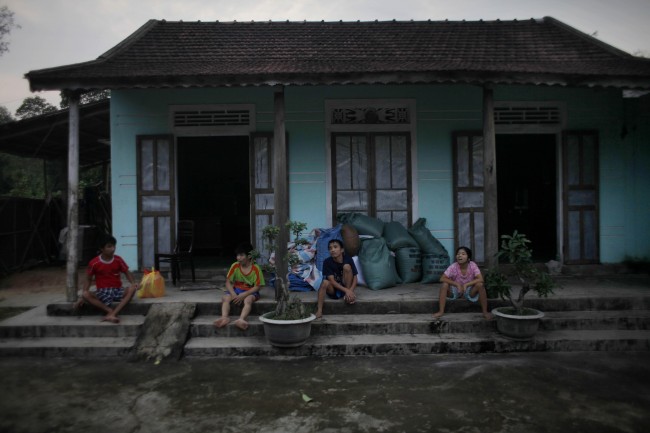
In this photo taken on Oct. 4, 2009, Vietnamese siblings, from left, Tran van Hoang, Tran Van Lam, Tran Van Luan and Tran Thi Luy, sit on the front porch of their family home in the village of Cam Tuyen, Vietnam. The siblings were born with profound physical and mental disabilities that the family, and local officials say, were caused by their parents’ exposure to the chemical dioxin in the defoliant Agent Orange.
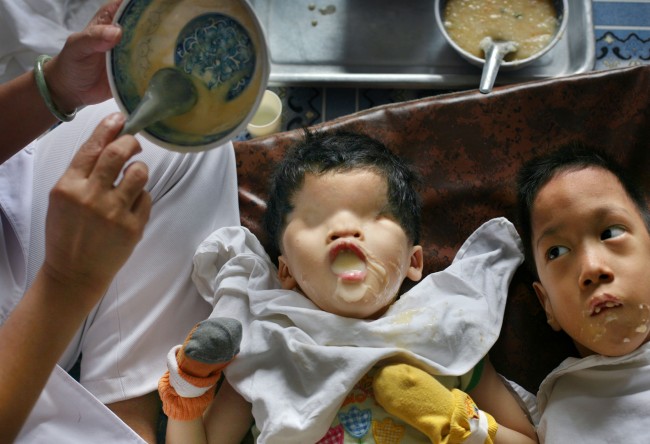
*Five-year-old girl Tran Huynh Thuong Sinh, who was born without eyes in the Binh Dinh province of Vietnam, is fed breakfast by a nurse at the “Peace Village” center at Tu Du hospital in Ho Chi Minh City, Vietnam, in this May 25, 2007, file photo. Officials at the hospital suspect that the dioxin in Agent Orange blocks the receptors in a developing fetus, preventing the hormones that would normally instruct the cells to form eyes from doing so.
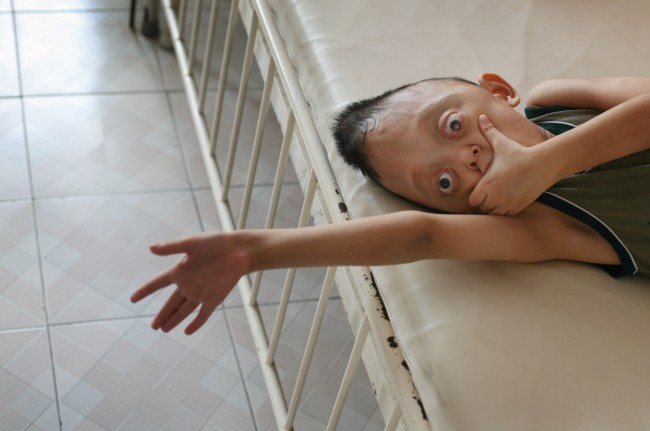
Nguyen Xuan Minh, age 6, rests in his bed at the “Peace Village” of Tu Du hospital in Ho Chi Minh City Friday, May 25, 2007. According to hospital staff, the boy is suffering from physical deformities suspected to have been caused by his parents’ exposure to dioxin in the chemical defoliant Agent Orange.
Make Agent Orange History:
In 1968, as a young obstetrician in Ho Chi Minh City, Dr. Nguyen Thi Ngoc Phuong began to notice a strange pattern among the babies being born. “It was horrible,” Dr. Phuong recalls of her days working at Tu Du Hospital. “Every week we had about 2 or 3 or 4 cases of deformed babies born in the hospital. No eyes, no nose, deformed mouths.”
She was shocked and saddened by such a strange pattern, but it wasn’t until the end of the war in 1975 that Dr. Phuong began to see the connection between these deformities and the war in Vietnam.
“Many American veterans came to Tu Du hospital and asked about birth defects and cancers related to toxic chemicals sprayed over the southern part of Vietnam during the war,” Dr. Phuong recalls.
She was compelled to investigate, and has subsequently devoted her career to getting to the bottom of this issue. Her research has found that the percentage of reproductive problems, birth defects and other diseases is higher for people living in parts of Vietnam that were sprayed with Agent Orange/dioxin than for the general population. Moreover, the breast milk of mothers living in these areas contains dangerously elevated levels of dioxin (the toxic contaminant in Agent Orange) – an indicator that this problem is far from over for the affected Vietnamese.
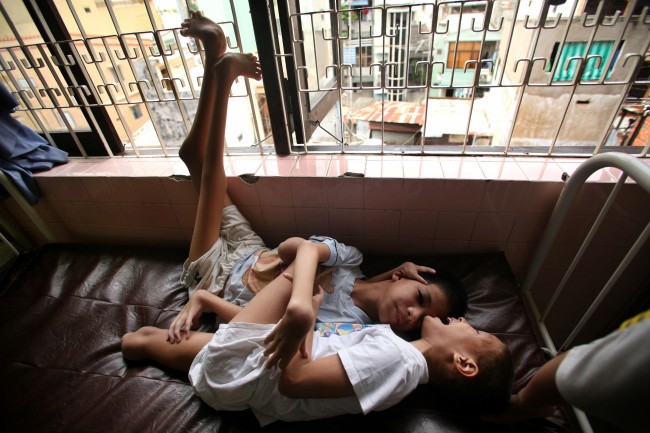
Trien Meng Hiep, 9, against wall, is hugged by another boy at a “Peace Village” center in Tu Du hospital in Ho Chi Minh City, Vietnam on Friday, May 25, 2007. Both of the boys were born with severe physical deformities typical of spina bifida and which hospital officials suspect to have been caused by their parents exposure to dioxin in the chemical defoliant Agent Orange.
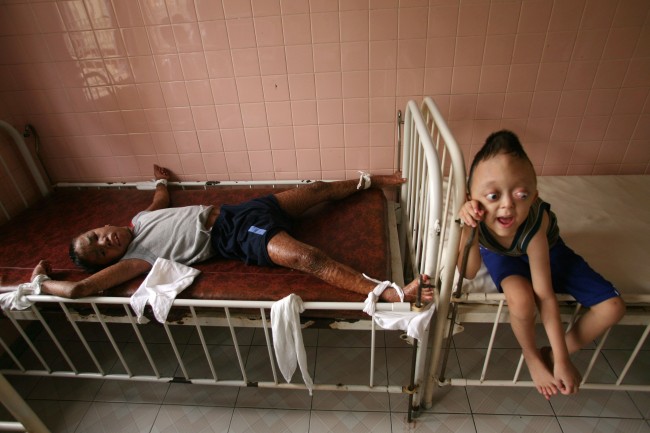
Thirteen-year-old Tran Minh Anh, left, who was born in Long An Province and suffers from a disease called X-linked ichthyosis, is tied down to a bed to protect from hurting himself at the “Peace Village” of Tu Du hospital in Ho Chi Minh City, May 25, 2007. On the right is Nguyen Xuan Minh, age 6. Accoding to hospital staff, both boys are suffering from conditions suspected to have been caused by exposure by their parents to dioxin in the chemical defoliant Agent Orange.
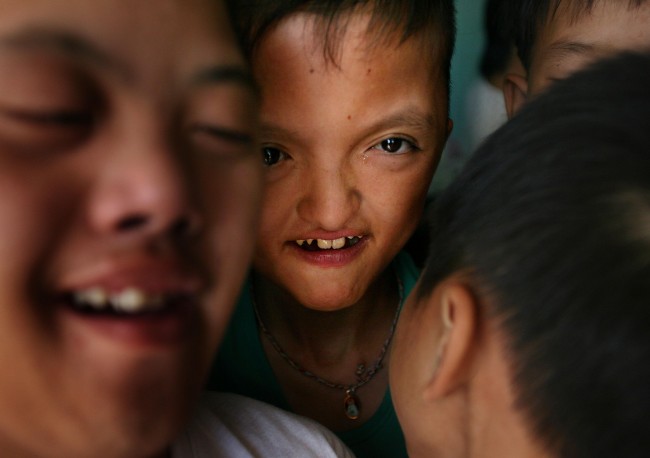
*A group of boys play together at a center for Agent Orange victims in Danang, Vietnam, in this May 21, 2007, file photo. More than 30 years after the Vietnam War ended, the poisonous legacy of Agent Orange has emerged anew with a scientific study that has found extraordinarily high levels of health-threatening contamination at the former U.S. air base at Danang.
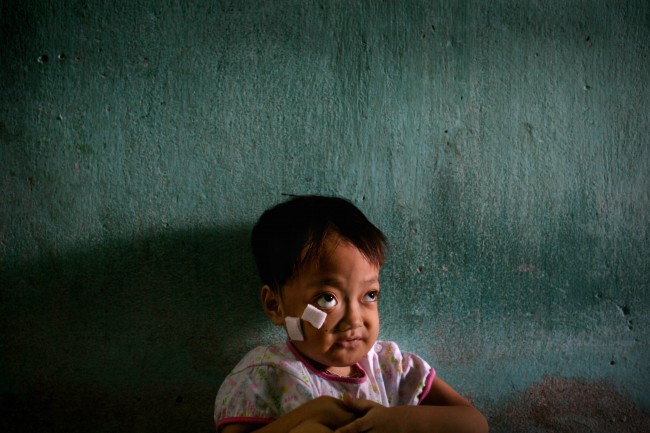
*Nguyen Thi Kieu Nhung sits inside her family home next to the Danang airbase in Danang, Vietnam, in this May 21, 2007, file photo. The girl was born with physical deformities, including twisted limbs, a misshapen head, and protruding eyes suspected by local health officials to have been caused by dioxin in the chemical defoliant Agent Orange. More than 30 years after the Vietnam War ended, the poisonous legacy of Agent Orange has emerged anew with a scientific study that has found extraordinarily high levels of health-threatening contamination at the former U.S. air base at Danang.
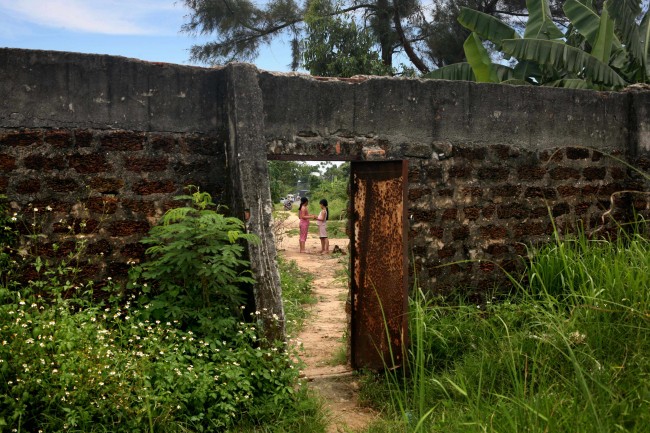
** ONE IN A SERIES OF 15 PHOTOS BY AP PHOTOGRAPHER DAVID GUTTENFELDER WHICH WON THE APME PHOTO CONTEST FEATURE CATEGORY–FILE **Two young girls play in their village, seen through a door in the wall of the Danang airbase in Danang, Vietnam, in this May 21, 2007, file photo. More than 30 years after the Vietnam War ended, the poisonous legacy of Agent Orange has emerged anew with a scientific study that has found extraordinarily high levels of health-threatening contamination at the former U.S. air base at Danang.
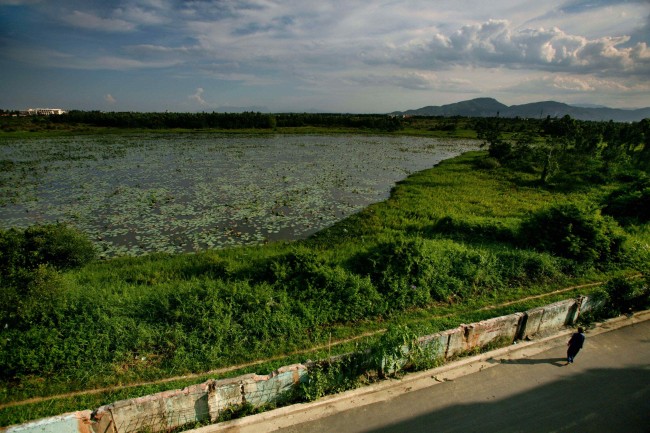
*A woman walks next to a highly contaminated pond around the grounds of the Danang airbase in Danang, Vietnam, int this May 21, 2007, file photo. More than 30 years after the Vietnam War ended, the poisonous legacy of Agent Orange has emerged anew with a scientific study that has found extraordinarily high levels of health-threatening contamination at the former U.S. air base at Danang.
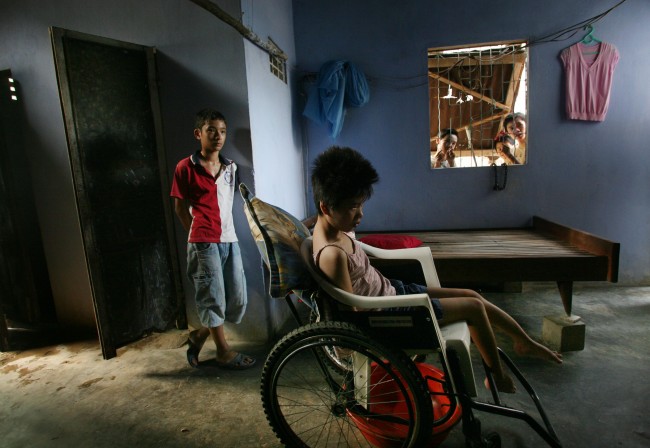
**Neighborhood children look through a window at Tran Thi Le Huyen, 23, sitting in a wheelchair in her family home in Danang, Vietnam in this May 21, 2007, file photo. The young woman has been listed by the Vietnamese government as a victim of Agent Orange contamination. Her family once lived near the highly contaminated Danang Airbase and her father was a driver for the US-backed south Vietnamese government during the war. Her family receives a small stipend and her wheelchair from the government.
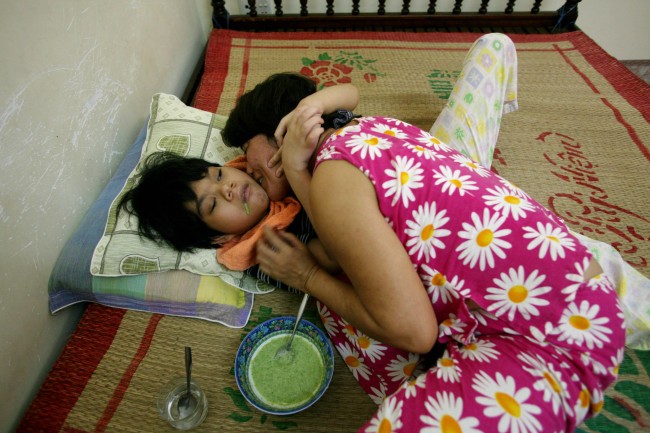
Ngyuyen Thi Thuy Lieu kisses and hugs her daughter Ngyuyen Thi Trang Ngan as she feeds her lunch on their family bed at their home in Danang, Vietnam on Monday, May 21, 2007. Ngyuyen Thi Thuy Lieu, who grew up next to the U.S. military base inside Denang airbase, has given birth to two children with physical and mental disabilities. More than 30 years after the Vietnam War ended, the poisonous legacy of Agent Orange has emerged anew with a scientific study that has found extraordinarily high levels of health-threatening contamination at the former U.S. air base at Danang.
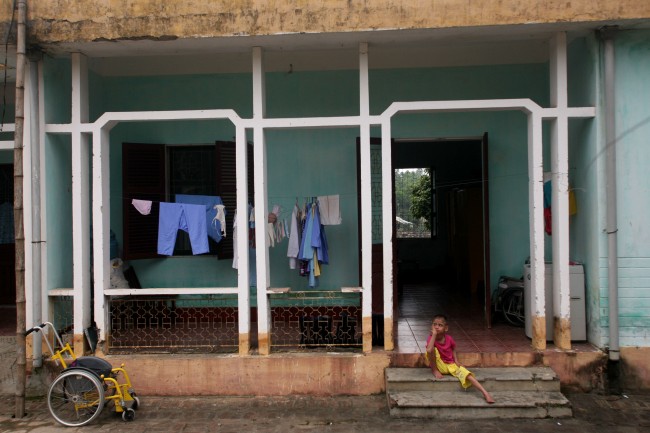
A physically and mentally disabled child sits on the steps of a hospital ward at a “peace village” center in the village of Thuy An, Vietnam, which houses people suffering from illnesses and deformities associated with contact to dioxin in chemical defoliant Agent Orange, in this May 15, 2007, file photo
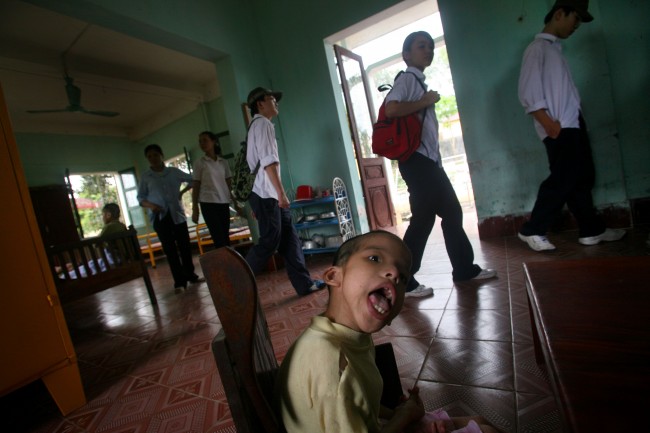
Vietnamese high school children visit a “peace village” center at a hospital in the village of Thuy An, Vietnam which cares for physically and mentally disabled children suspected to have been harmed by exposure to dioxin in the chemical defoliant Agent Orange, in this May 15, 2007, file photo.
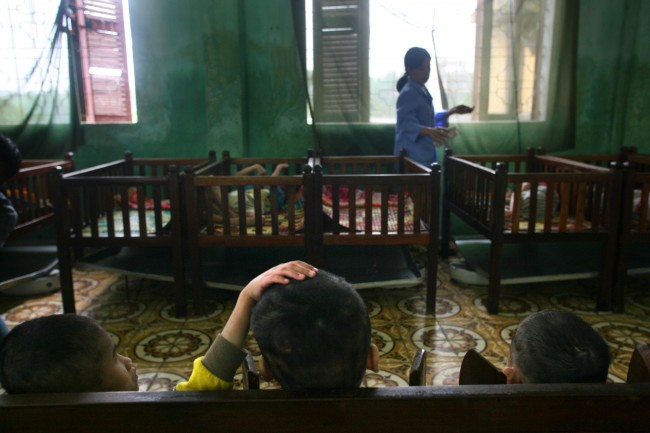
Physically and mentally disabled children sit in their room at a “peace village” center for people suspected to have been damaged by the dioxin found in the chemical defoliant Agent Orange and other illnesses, in the village of Thuy An, Vietnam on Tuesday, May 15, 2007.
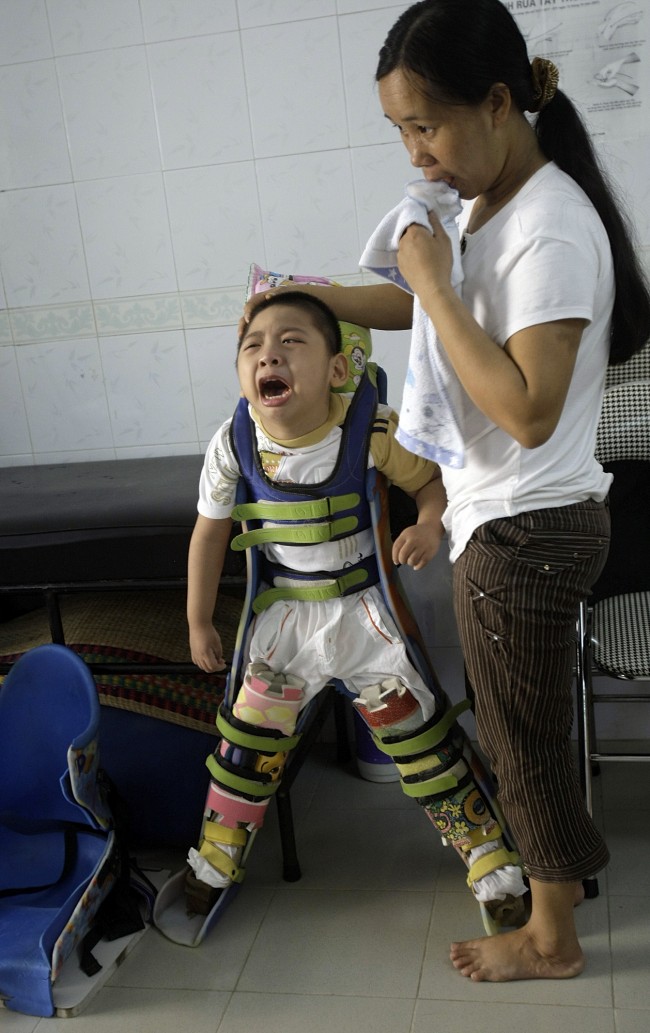

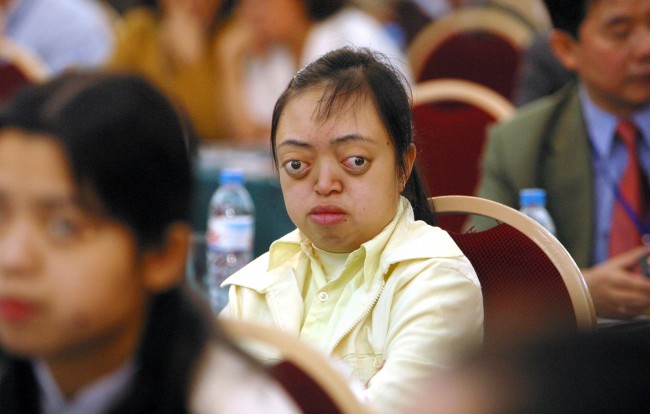
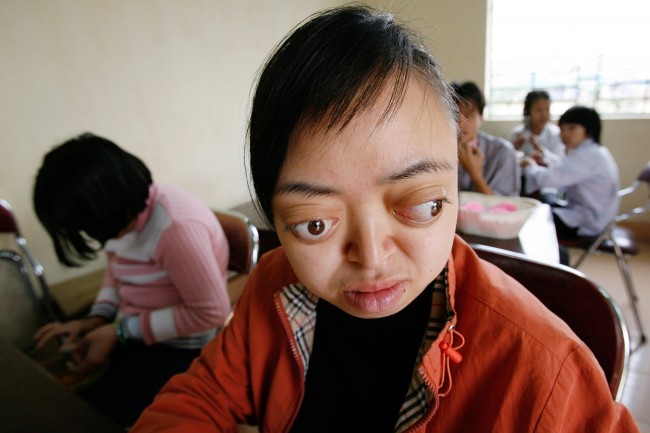
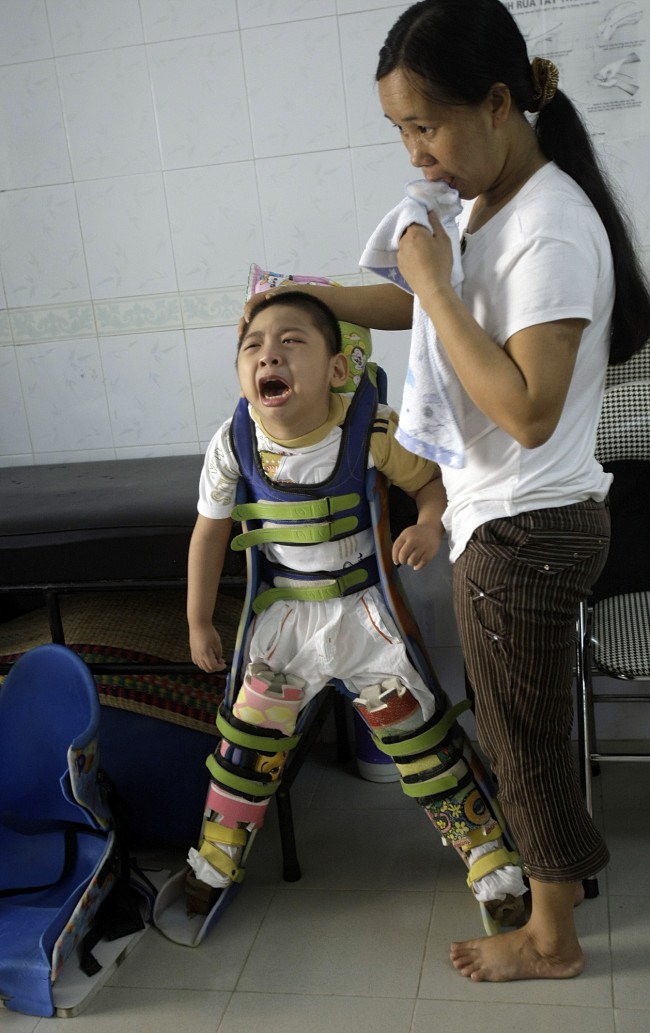
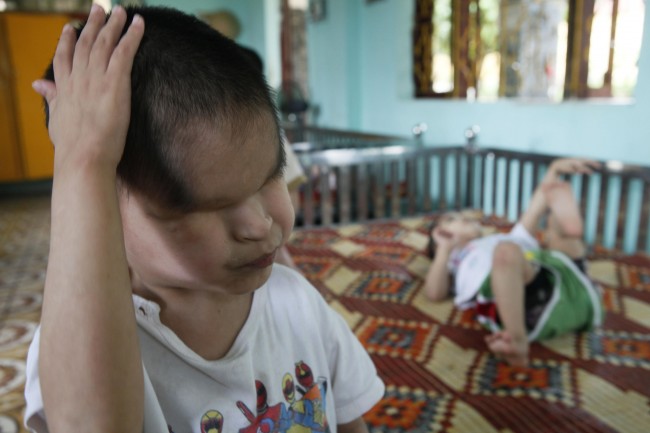
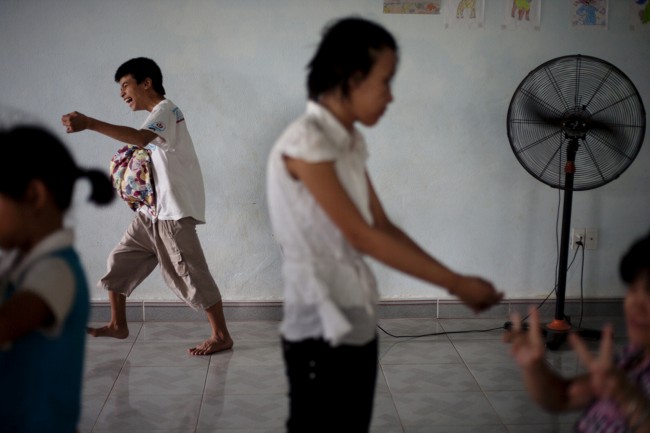
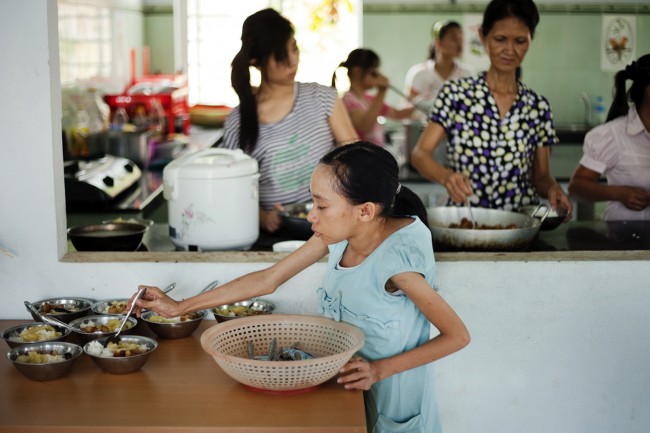
In this photo taken on Wednesday, Aug. 8, 2012, Ho Thi Lang, foreground, helps prepare lunch for other children at a rehabilitation center in Danang, Vietnam. The children were born with physical and mental disabilities that the center’s director says were caused by their parents’ exposure to the chemical dioxin in the defoliant Agent Orange. On Thursday, the U.S. for the first time will begin cleaning up leftover dioxin that was stored at the former military base that’s now part of Danang’s airport.
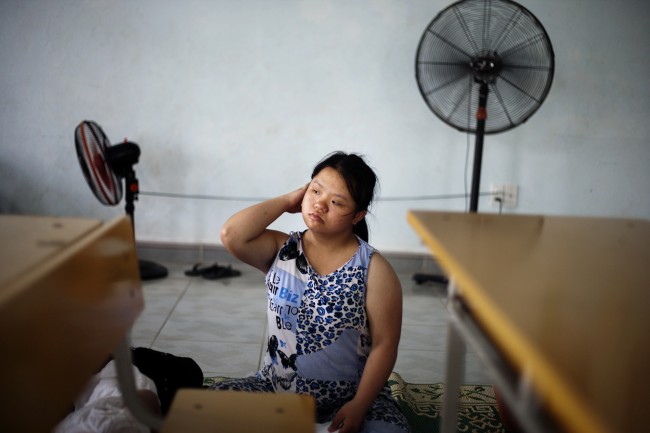
In this photo taken Tuesday Aug. 7, 2012, Le Thi Kim Lien wakes up after noon’s nap at a rehabilitation center in Danang, Vietnam. The children were born with physical and mental disabilities that the center’s director said were caused by their parents’ exposure to the chemical dioxin in the defoliant Agent Orange. Washington was slow to respond, but on Thursday, Aug. 9, 2012 the U.S. for the first time will begin cleaning up leftover dioxin that was stored at the former military base, now part of Danang’s airport.
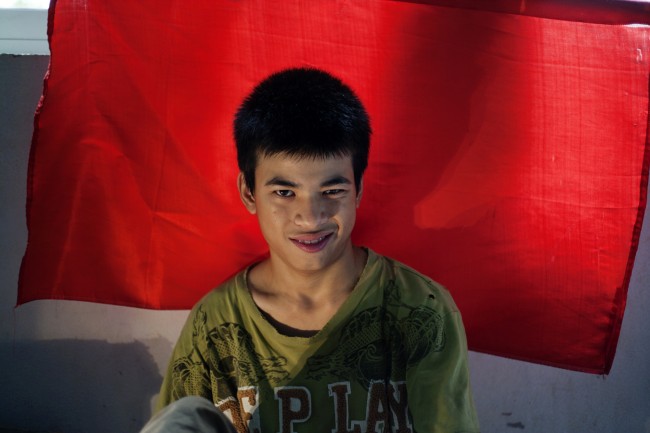
In this photo taken on Aug. 8, 2012, Dang Cong Chinh, 17, smiles at a rehabilitation center in Danang, Vietnam.

In this photo taken on Aug. 8, 2012, Dang Cong Chinh, 17, smiles at a rehabilitation center in Danang, Vietnam.

In this photo taken on Wednesday, Aug. 8, 2012, Ho Thi Lang, foreground, helps prepare lunch for other children at a rehabilitation center in Danang, Vietnam. The children were born with physical and mental disabilities that the center’s director says were caused by their parents’ exposure to the chemical dioxin in the defoliant Agent Orange. On Thursday, the U.S. for the first time will begin cleaning up leftover dioxin that was stored at the former military base that’s now part of Danang’s airport.

In this photo taken Tuesday Aug. 7, 2012, Le Thi Kim Lien wakes up after noon’s nap at a rehabilitation center in Danang, Vietnam. The children were born with physical and mental disabilities that the center’s director said were caused by their parents’ exposure to the chemical dioxin in the defoliant Agent Orange. Washington was slow to respond, but on Thursday, Aug. 9, 2012 the U.S. for the first time will begin cleaning up leftover dioxin that was stored at the former military base, now part of Danang’s airport.
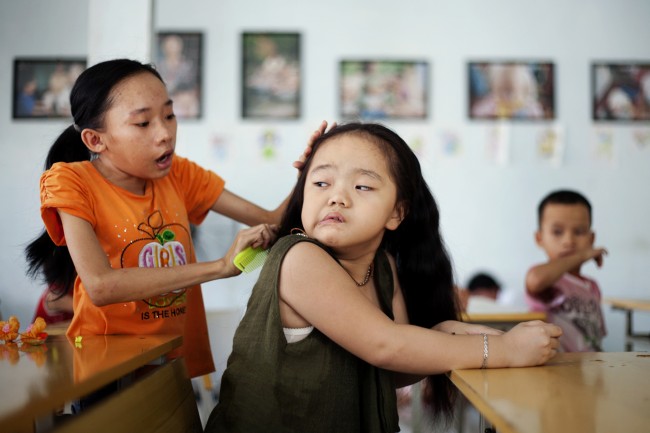
In this photo taken Aug. 7, 2012, Ho Thi Lang, left, combs Ngo Diep Uyen’s hair after her nap at a rehabilitation center in Danang, Vietnam.

In this photo taken on Aug. 7, 2012, Dang Cong Kien, 18, rear, and Dang Thi Khanh Mai, 17, center in foreground, prepare for a nap at a rehabilitation center in Danang, Vietnam.

Nguyen Tuan Tu, a second generation Agent Orange victim who was born without eyes

Tran Tien Dat, 4, is seen during a rehabilitation session with his aunt Doan Thi Quyen at Thanh Xuan Peace Village in Hanoi, Vietnam

Nguyen Thi Van Long, 20, with birth defects believed to be caused by Agent Orange, works in her classroom at the Friendship Village on the outskirts of Hanoi, Vietnam on Wednesday, March 29, 2006. Civilians and Vietnam war veterans from several countries held a two-day conference to plead for recognition of health problems they say are associated with Agent Orange, the chemical defoliant U.S. forces sprayed during the war.

Nguyen Van Long, 20, believed to be a victim of Agent Orange, listens to speeches at an international conference of Agent Orange Victims in Hanoi, Vietnam, Tuesday, March 28, 2006. Participants hope to raise more awareness of the issue and demand U.S. government and toxic chemical companies to compensate for the victims.

More Galleries
Posted: 5th, March 2014 | In: In Pictures, Reviews Comment | TrackBack | Permalink








